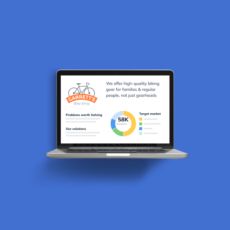Writing a business plan can be simple and impactful. In this guide, you’ll learn how to write a detailed plan that impresses bankers and investors, while helping you start, run, and grow a successful business.
Understanding the basics of business planning is crucial. You already know why you need a business plan – it helps you raise money, grow strategically, and stay on track. As you start writing your plan, remember that it’s an overview of your products, services, and customers. It explains your business strategy, marketing tactics, and financial forecasts.
A good business plan is more than a one-time document. It’s a guide that helps you outline and achieve your goals. You can use it as a management tool to track your progress, update your forecasts, and run a smarter business.
Now, let’s discuss what to include in your business plan:
– Executive summary: Summarize your business, products, target market, team, financials, and funding requirements.
– Products and services description: Explain how your offerings solve a problem for your target market and highlight any competitive advantages.
– Market analysis: Describe your target market, including demographics and psychographics, and provide information about market growth and industry trends.
– Competitive analysis: Analyze your competitors and explain how your business is different, focusing on your unique advantages.
– Marketing and sales plan: Position your product or service in the market, outline your marketing strategy, and describe your sales tactics.
– Business operations: Detail the requirements for your business to run smoothly, including inventory, supply chain management, manufacturing processes, equipment, and distribution.
– Key milestones and metrics: Set specific tasks, due dates, and responsible parties for key milestones, and track metrics like conversion rates and customer acquisition costs.
– Organization and management team: Highlight the experiences and qualifications of your team, and describe your company’s ownership structure.
– Financial plan: Create financial forecasts such as sales, expenses, profit and loss, cash flow, and balance sheet. Include assumptions and potential risks.
– Appendix: Supplement your plan with additional data, charts, or information.
– Optional: Business plan cover page: Add a simple cover page with your company logo, name, plan title, completion date, and contact information.
AI tools like ChatGPT can help speed up the writing process and assist with concepts like market segmentation and competition. However, use AI as a collaborator, not a replacement for human creativity.
Here are some additional tips for writing your business plan:
– Determine why you’re writing the plan to guide your approach.
– Keep your plan concise, focusing on the essentials.
– Have someone review your plan to ensure clarity and understanding.
– Use free templates and examples to get started or seek professional assistance.
– Avoid common mistakes like not talking to your customers, making overly optimistic forecasts, spending too much time planning, and not revising the plan.
– Present your plan as a pitch presentation, summarizing the key points.
– Use your plan as a management tool to track progress, compare against actual results, and make adjustments.
Now that you have the knowledge, start writing your impactful business plan using the provided templates and examples. Good luck!

Free business plan template: Download an SBA-approved template built for small businesses and startups.

Download a free one-page plan template to write a useful business plan in just 30 minutes.

Sample business plan library – Explore 500 business plan examples from various industries. View Sample Plans.

Write your plan faster with LivePlan. Try the business planning and growth tool trusted by over 1-million business owners. Start your plan. How to write a business plan FAQ. What is a business plan? A document that describes your business, the products and services you sell, and the customers that you sell to. It explains your business strategy, how you’re going to build and grow your business, your marketing strategy, and your competitors. What are the benefits of a business plan? A business plan helps you understand where you want to go with your business and what it will take to get there. It reduces your risk, helps you uncover your business’s potential, attracts investors, and identifies areas for growth. Having a business plan makes you more confident as a business owner and more likely to succeed. What are the 7 steps of a business plan? The seven steps include: Write a brief executive summary, describe your products and services, conduct market research and compile data into a market analysis, describe your marketing and sales strategy, outline your organizational structure and management team, develop financial projections for sales, revenue, and cash flow, and add any additional documents to your appendix. What are the 5 most common business plan mistakes? The five most common mistakes include: not taking the planning process seriously, having unrealistic financial projections or incomplete financial information, inconsistent information or simple mistakes, failing to establish a sound business model, and not having a defined purpose for your business plan. What questions should be answered in a business plan? Key questions to ask and answer include: How will your business make money? Is there a need for your product or service? Who are your customers? How are you different from the competition? How will you reach your customers? How will you measure success? How long should a business plan be? The length depends on what you intend to do with it. From the lender’s point of view, a business plan needs to fully explain your business. If for internal purposes, a one-page plan can be enough. What are the different types of business plans? Traditional business plan: a formal document for funding or pitching to investors. Business model canvas: a one-page template that demystifies the planning process. One-page business plan: a simplified version that focuses on core aspects. Lean Plan: a methodology for continuous planning, testing, and refining. What’s the difference between a business plan and a strategic plan? A business plan describes the current state and functions of your business, while a strategic plan explores long-term goals and how they will be achieved. However, a lean business plan can serve as both.
Hello!
I’m Andrew Brooks, a seasoned finance consultant from the USA and the mind behind phonenumber247.com.
My career is built on a foundation of helping individuals and businesses thrive financially in an ever-changing economic landscape. At phonenumber247.com, my aim is to demystify the complex world of finance, providing clear, actionable advice that can help you navigate your financial journey with confidence. Whether it’s personal finance management, investment strategies, or understanding the nuances of market dynamics, I’m here to share insights and tools that can propel you towards your financial goals.
Welcome to my digital space, where every piece of advice is a step closer to financial clarity and success!
